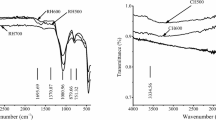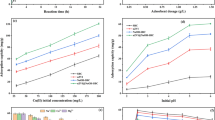Abstract
It is crucial that a highly effective adsorbent can be used to simultaneously remove the composite pollution including both inorganic and organic arsenic from wastewater. In this work, the iron modified corncob biochar (MCCB), prepared via the co-precipitation of ferric chloride hexahydrate (FeCl3⋅6H2O) with sodium hydroxide (NaOH) on corncob biochar, was studied for the high efficiency removal of arsenilic acid (ASA) and arsenate [As(V)] in wastewater. X-ray diffraction, scanning electron microscopy, and fourier transform infrared spectroscopy were carried out to characterize the MCCB. At pH of 4.0–5.0, initial concentration of 10 mg/L ASA and 1 mg/L As(V), adsorbent dose of 0.4 g/L, the maximum adsorption capacities of ASA and As(V) were 49.20 and 4.89 mg/g, respectively. The adsorption performance of MCCB for ASA and As(V) was fitted well to the pseudo-second-order kinetic model. Results from this study indicate the promise of MCCB as an efficient, low-cost and environmentally friendly adsorbent for composite arsenic pollution.








Similar content being viewed by others
References
Benis KZ, Damuchali AM, Soltan J, McPhedran KN (2020) Treatment of aqueous arsenic-a review of biochar modification methods. Sci Total Environ 739:139750
Borges GA, Ferreira GMD, Siqueira KPF, Dias A, Navarro KON, Silva S (2020) Adsorption of organic and inorganic arsenic from aqueous solutions using MgAl-LDH with incorporated nitroprusside. J Colloid Interface Sci 575:194–205
Cope CO, Webster DS, Sabatini DA (2014) Arsenate adsorption onto iron oxide amended rice husk char. Sci Total Environ 488:558–565
Fan JM, Xu X, Ni QL, Lin Q, Fang J, Chen Q (2018) Enhanced As (V) removal from aqueous solution by biochar prepared from iron-impregnated corn straw. J Chem 2018:5137694
Fierro V, Muniz G, Gonzalez-Sanchez G, Ballinas ML, Celzard A (2009) Arsenic removal by iron-doped activated carbons prepared by ferric chloride forced hydrolysis. J Hazard Mater 168:430–437
Fisher DJ, Yonkos LT, Staver KW (2015) Environmental concerns of roxarsone in broiler poultry feed and litter in maryland, USA. Environ Sci Technol 49:1999–2012
Guo S, Feng B, Zhang H (2011) Simultaneous determination of tracearsenic and antimony in Fomes Offificinalis Ames with hydride generation atomic fluorescence spectrometry. J Fluoresc 21:1281–1284
He RZ, Peng ZY, Lyu HH, Huang H, Nan Q, Tang JC (2018) Synthesis and characterization of an iron-impregnated biochar for aqueous arsenic removal. Sci Total Environ 612:1177–1186
Kaartinen T, Laine-Ylijoki J, Ahoranta S, Korhonen T, Neitola R (2017) Arsenic removal from mine waters with sorption techniques. Miner Water Environ 36:199–208
Kim J, Song J, Lee S-M, Jung J (2019) Application of iron-modified biochar for arsenite removal and toxicity reduction. J Ind Eng Chem 80:17–22
Kumar A, Bhattacharya T (2021) Removal of arsenic by wheat straw biochar from soil. Bull Environ Contam Toxicol 108:415–422
Li Y, Bland GD, Yan WL (2016) Enhanced arsenite removal through surface-catalyzed oxidative coagulation treatment. Chemosphere 150:650–658
Li W, Li J, Cheng L, Gu Z, Sun C, Hong Y (2021) Characterization the structural property and degradation behavior of corn starch in KOH/thiourea aqueous solution. Carbohydr Polym 270:118363
Lin JB, Yuan SJ, Wang W, Hu ZH, Yu HQ (2016) Precipitation of organic arsenic compounds and their degradation products during struvite formation. J Hazard Mater 317:90–96
Lin X, Wang L, Jiang S, Cui L, Wu G (2019) Iron-doped chitosan microsphere for As(III) adsorption in aqueous solution: Kinetic, isotherm and thermodynamic studies. Korean J Chem Eng 36:1102–1114
Lin C, Ping M, Zhang X, Wang X, Chen L, Wu Y (2021) In vitro bio-accessibility and distribution characteristic of each arsenic species in different fishes and shellfishes/shrimps collected from Fujian of China. J Hazard Mater 420:126660
Luo MK, Lin H, He YH, Zhang Y (2020) The influence of corncob-based biochar on remediation of arsenic and cadmium in yellow soil and cinnamon soil. Sci Total Environ 717:137014
Malik AH, Khan ZM, Mahmood Q, Nasreen S, Bhatti ZA (2009) Perspectives of low cost arsenic remediation of drinking water in Pakistan and other countries. J Hazard Mater 168:1–12
Mohan D, Pittman CU Jr (2007) Arsenic removal from water/wastewater using adsorbents-a critical review. J Hazard Mater 142:1–53
Nakajima T, Xu YH, Mori Y, Kishita M, Takanashi H, Maeda S (2005) Combined use of photocatalyst and adsorbent for the removal of inorganic arsenic(III) and organoarsenic compounds from aqueous media. J Hazard Mater 120:75–80
Nguyen TH, Pham TH, Nguyen Thi HT, Nguyen TN, Nguyen M-V, Tran Dinh T (2019) Synthesis of iron-modified biochar derived from rice straw and its application to arsenic removal. J Chem 2019:1–8
Peng X, Chen L, Liu S, Hu L, Zhang J, Wang A (2021) Insights into the interfacial interaction mechanisms of p-arsanilic acid adsorption on ionic liquid modified porous cellulose. J Environ Chem Eng 9:105225
Sattar MS, Shakoor MB, Ali S, Rizwan M, Niazi NK, Jilani A (2019) Comparative efficiency of peanut shell and peanut shell biochar for removal of arsenic from water. Environ Sci Pollut Res 26:18624–18635
Shi Z, Jin C, Zhang J, Zhu L (2019) Insight into mechanism of arsanilic acid degradation in permanganate-sulfite system: role of reactive species. Chem Eng J 359:1463–1471
Sun T, Shi Z, Zhang X, Wang X, Zhu L, Lin Q (2019) Efficient degradation of p-arsanilic acid with released arsenic removal by magnetic CeO2-Fe3O4 nanoparticles through photo-oxidation and adsorption. J Alloys Compd 808:151689
Tang R, Wang YL, Yuan SJ, Wang W, Yue ZB, Zhan XM (2021) Organoarsenic feed additives in biological wastewater treatment processes: removal, biotransformation, and associated impacts. J Hazard Mater 406:124789
Tian C, Zhao J, Zhang J, Chu SQ, Dang Z, Lin Z (2017) Enhanced removal of roxarsone by Fe3O4@3D graphene nanocomposites: synergistic adsorption and mechanism. Environ Sci-Nano 4:2134–2143
Wang S, Gao B, Li Y, Mosa A, Zimmerman AR, Ma LQ (2015) Manganese oxide-modified biochars: preparation, characterization, and sorption of arsenate and lead. Bioresour Technol 181:13–17
Wu Q, Ye XX, Lv YC, Pei RH, Wu MY, Liu MH (2020) Lignin-based magnetic activated carbon for p-arsanilic acid removal: applications and adsorption mechanisms. Chemosphere 258:127276
Yang X, Zhang S, Ju M, Liu L (2019) Preparation and modification of biochar materials and their application in soil remediation. Appl Sci 9:1002–1022
Zang S, Zuo Y, Wang J, Liu X, Gomez MA, Wei L (2021) Adsorption removal of roxarsone, arsenite(III), and arsenate(V) using iron-modified sorghum straw biochar and its kinetics. Acta Geochimica 40:409–418
Zhang M, Jia J, Huang K, Hou X, Zheng C (2018) Facile electrochemical synthesis of nano iron porous coordination polymer using scrap iron for simultaneous and cost-effective removal of organic and inorganic arsenic. Chin Chem Lett 29:456–460
Zhao Y, Zhao H, Abashina T, Vainshtein M (2021) Review on arsenic removal from sulfide minerals: an emphasis on enargite and arsenopyrite. Miner Eng 172:123624
Acknowledgements
This work was supported by the National Natural Science Foundation of China (Grant Nos. 41773136 and 41703129), Scientific Research Fund of Liaoning Provincial Department of Education (LZD202004).
Author information
Authors and Affiliations
Corresponding author
Additional information
Publisher's Note
Springer Nature remains neutral with regard to jurisdictional claims in published maps and institutional affiliations.
Rights and permissions
About this article
Cite this article
Zang, S., Qiu, H., Sun, C. et al. High Efficiency Adsorption Removal of Arsenilic Acid and Arsenate(V) by Iron-Modified Corncob Biochar. Bull Environ Contam Toxicol 109, 379–385 (2022). https://doi.org/10.1007/s00128-022-03536-0
Received:
Accepted:
Published:
Issue Date:
DOI: https://doi.org/10.1007/s00128-022-03536-0




